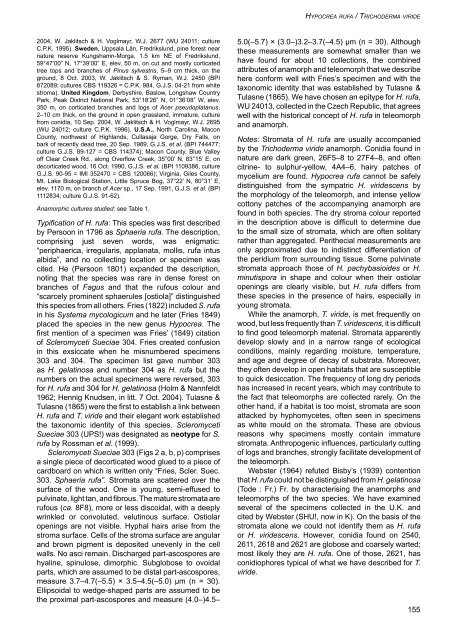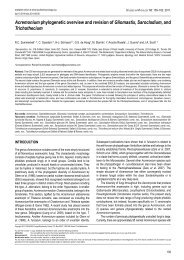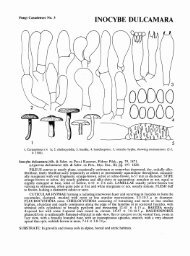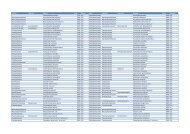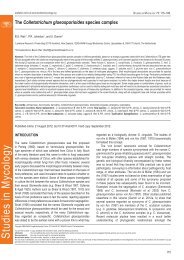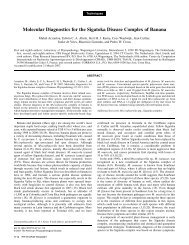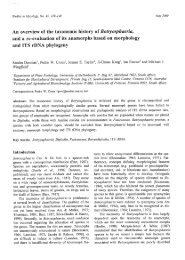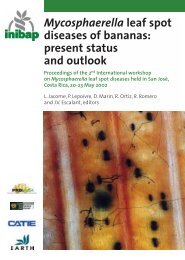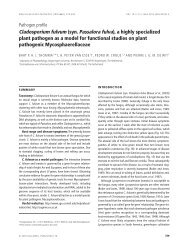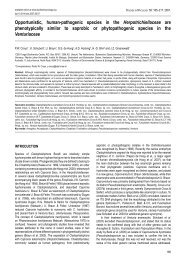Hypocrea rufa/Trichoderma viride: a reassessment, and ... - CBS
Hypocrea rufa/Trichoderma viride: a reassessment, and ... - CBS
Hypocrea rufa/Trichoderma viride: a reassessment, and ... - CBS
You also want an ePaper? Increase the reach of your titles
YUMPU automatically turns print PDFs into web optimized ePapers that Google loves.
2004, W. Jaklitsch & H. Voglmayr, W.J. 2677 (WU 24011; culture<br />
C.P.K. 1995). Sweden, Uppsala Län, Fredrikslund, pine forest near<br />
nature reserve Kungshamn-Morga, 1.5 km NE of Fredrikslund,<br />
59°47’00” N, 17°39’00” E, elev. 50 m, on cut <strong>and</strong> mostly corticated<br />
tree tops <strong>and</strong> branches of Pinus sylvestris, 5–9 cm thick, on the<br />
ground, 8 Oct. 2003, W. Jaklitsch & S. Ryman, W.J. 2450 (BPI<br />
872089; cultures <strong>CBS</strong> 119326 = C.P.K. 984, G.J.S. 04-21 from white<br />
stroma). United Kingdom, Derbyshire, Baslow, Longshaw Country<br />
Park, Peak District National Park, 53°18’26” N, 01°36’08” W, elev.<br />
350 m, on corticated branches <strong>and</strong> logs of Acer pseudoplatanus,<br />
2–10 cm thick, on the ground in open grassl<strong>and</strong>, immature, culture<br />
from conidia, 10 Sep. 2004, W. Jaklitsch & H. Voglmayr, W.J. 2695<br />
(WU 24012; culture C.P.K. 1996). U.S.A., North Carolina, Macon<br />
County, northwest of Highl<strong>and</strong>s, Cullasaja Gorge, Dry Falls, on<br />
bark of recently dead tree, 20 Sep. 1989, G.J.S. et al. (BPI 744477;<br />
culture G.J.S. 89-127 = <strong>CBS</strong> 114374); Macon County, Blue Valley<br />
off Clear Creek Rd., along Overflow Creek, 35°00’ N, 83°15’ E, on<br />
decorticated wood, 16 Oct. 1990, G.J.S. et al. (BPI 1109386, culture<br />
G.J.S. 90-95 = IMI 352470 = <strong>CBS</strong> 120066); Virginia, Giles County,<br />
Mt. Lake Biological Station, Little Spruce Bog, 37°22’ N, 80°31’ E,<br />
elev. 1170 m, on branch of Acer sp., 17 Sep. 1991, G.J.S. et al. (BPI<br />
1112834; culture G.J.S. 91-62).<br />
Anamorphic cultures studied: see Table 1.<br />
Typification of H. <strong>rufa</strong>: This species was first described<br />
by Persoon in 1796 as Sphaeria <strong>rufa</strong>. The description,<br />
comprising just seven words, was enigmatic:<br />
“periphaerica, irregularis, applanata, mollis, <strong>rufa</strong> intus<br />
albida”, <strong>and</strong> no collecting location or specimen was<br />
cited. He (Persoon 1801) exp<strong>and</strong>ed the description,<br />
noting that the species was rare in dense forest on<br />
branches of Fagus <strong>and</strong> that the rufous colour <strong>and</strong><br />
“scarcely prominent sphaerules [ostiola]” distinguished<br />
this species from all others. Fries (1822) included S. <strong>rufa</strong><br />
in his Systema mycologicum <strong>and</strong> he later (Fries 1849)<br />
placed the species in the new genus <strong>Hypocrea</strong>. The<br />
first mention of a specimen was Fries’ (1849) citation<br />
of Scleromyceti Sueciae 304. Fries created confusion<br />
in this exsiccate when he misnumbered specimens<br />
303 <strong>and</strong> 304. The specimen list gave number 303<br />
as H. gelatinosa <strong>and</strong> number 304 as H. <strong>rufa</strong> but the<br />
numbers on the actual specimens were reversed, 303<br />
for H. <strong>rufa</strong> <strong>and</strong> 304 for H. gelatinosa (Holm & Nannfeldt<br />
1962; Hennig Knudsen, in litt. 7 Oct. 2004). Tulasne &<br />
Tulasne (1865) were the first to establish a link between<br />
H. <strong>rufa</strong> <strong>and</strong> T. <strong>viride</strong> <strong>and</strong> their elegant work established<br />
the taxonomic identity of this species. Scleromyceti<br />
Sueciae 303 (UPS!) was designated as neotype for S.<br />
<strong>rufa</strong> by Rossman et al. (1999).<br />
Scleromyceti Sueciae 303 (Figs 2 a, b, p) comprises<br />
a single piece of decorticated wood glued to a piece of<br />
cardboard on which is written only “Fries, Scler. Suec.<br />
303. Sphaeria <strong>rufa</strong>”. Stromata are scattered over the<br />
surface of the wood. One is young, semi-effused to<br />
pulvinate, light tan, <strong>and</strong> fibrous. The mature stromata are<br />
rufous (ca. 8F8), more or less discoidal, with a deeply<br />
wrinkled or convoluted, velutinous surface. Ostiolar<br />
openings are not visible. Hyphal hairs arise from the<br />
stroma surface. Cells of the stroma surface are angular<br />
<strong>and</strong> brown pigment is deposited unevenly in the cell<br />
walls. No asci remain. Discharged part-ascospores are<br />
hyaline, spinulose, dimorphic. Subglobose to ovoidal<br />
parts, which are assumed to be distal part-ascospores,<br />
measure 3.7–4.7(–5.5) × 3.5–4.5(–5.0) μm (n = 30).<br />
Ellipsoidal to wedge-shaped parts are assumed to be<br />
the proximal part-ascospores <strong>and</strong> measure (4.0–)4.5–<br />
HYPOCREA RUFA / TRICHODERMA VIRIDE<br />
5.0(–5.7) × (3.0–)3.2–3.7(–4.5) μm (n = 30). Although<br />
these measurements are somewhat smaller than we<br />
have found for about 10 collections, the combined<br />
attributes of anamorph <strong>and</strong> teleomorph that we describe<br />
here conform well with Fries’s specimen <strong>and</strong> with the<br />
taxonomic identity that was established by Tulasne &<br />
Tulasne (1865). We have chosen an epitype for H. <strong>rufa</strong>,<br />
WU 24013, collected in the Czech Republic, that agrees<br />
well with the historical concept of H. <strong>rufa</strong> in teleomorph<br />
<strong>and</strong> anamorph.<br />
Notes: Stromata of H. <strong>rufa</strong> are usually accompanied<br />
by the <strong>Trichoderma</strong> <strong>viride</strong> anamorph. Conidia found in<br />
nature are dark green, 26F5–8 to 27F4–8, <strong>and</strong> often<br />
citrine- to sulphur-yellow, 4A4–6, hairy patches of<br />
mycelium are found. <strong>Hypocrea</strong> <strong>rufa</strong> cannot be safely<br />
distinguished from the sympatric H. <strong>viride</strong>scens by<br />
the morphology of the teleomorph, <strong>and</strong> intense yellow<br />
cottony patches of the accompanying anamorph are<br />
found in both species. The dry stroma colour reported<br />
in the description above is difficult to determine due<br />
to the small size of stromata, which are often solitary<br />
rather than aggregated. Perithecial measurements are<br />
only approximated due to indistinct differentiation of<br />
the peridium from surrounding tissue. Some pulvinate<br />
stromata approach those of H. pachybasioides or H.<br />
minutispora in shape <strong>and</strong> colour when their ostiolar<br />
openings are clearly visible, but H. <strong>rufa</strong> differs from<br />
these species in the presence of hairs, especially in<br />
young stromata.<br />
While the anamorph, T. <strong>viride</strong>, is met frequently on<br />
wood, but less frequently than T. <strong>viride</strong>scens, it is difficult<br />
to find good teleomorph material. Stromata apparently<br />
develop slowly <strong>and</strong> in a narrow range of ecological<br />
conditions, mainly regarding moisture, temperature,<br />
<strong>and</strong> age <strong>and</strong> degree of decay of substrata. Moreover,<br />
they often develop in open habitats that are susceptible<br />
to quick desiccation. The frequency of long dry periods<br />
has increased in recent years, which may contribute to<br />
the fact that teleomorphs are collected rarely. On the<br />
other h<strong>and</strong>, if a habitat is too moist, stromata are soon<br />
attacked by hyphomycetes, often seen in specimens<br />
as white mould on the stromata. These are obvious<br />
reasons why specimens mostly contain immature<br />
stromata. Anthropogenic influences, particularly cutting<br />
of logs <strong>and</strong> branches, strongly facilitate development of<br />
the teleomorph.<br />
Webster (1964) refuted Bisby’s (1939) contention<br />
that H. <strong>rufa</strong> could not be distinguished from H. gelatinosa<br />
(Tode : Fr.) Fr. by characterising the anamorphs <strong>and</strong><br />
teleomorphs of the two species. We have examined<br />
several of the specimens collected in the U.K. <strong>and</strong><br />
cited by Webster (SHU!, now in K). On the basis of the<br />
stromata alone we could not identify them as H. <strong>rufa</strong><br />
or H. <strong>viride</strong>scens. However, conidia found on 2540,<br />
2611, 2618 <strong>and</strong> 2621 are globose <strong>and</strong> coarsely warted;<br />
most likely they are H. <strong>rufa</strong>. One of those, 2621, has<br />
conidiophores typical of what we have described for T.<br />
<strong>viride</strong>.<br />
155


